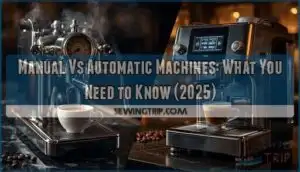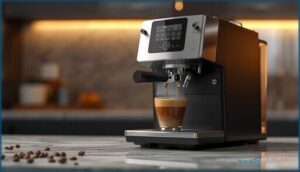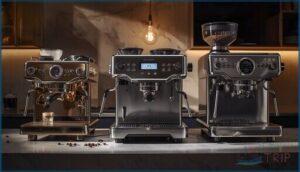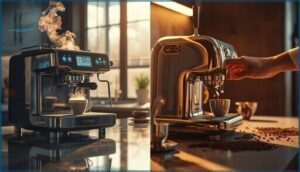This site is supported by our readers. We may earn a commission, at no cost to you, if you purchase through links.
You pull the lever, feel the resistance, watch the pressure gauge climb—then catch that first drip of espresso hitting the cup. That’s manual brewing. Or you press a button, walk away, and return to a perfectly pulled shot with microfoam already swirling on top. That’s automatic.
The difference between manual and automatic machines isn’t just about effort—it’s about who controls the variables that make or break your espresso. Manual machines hand you the reins completely: grind size, tamp pressure, water temperature, and extraction time all live in your hands. Automatic systems take over the technical work, prioritizing speed and consistency over customization.
Your choice hinges on whether you want total control with a steep learning curve or repeatable results with minimal intervention.
Table Of Contents
Key Takeaways
- Manual espresso machines give you complete control over every brewing variable—grind size, tamp pressure, temperature, and extraction timing—but demand 20-40 hours of training before you can consistently pull good shots.
- Automatic machines cut shot-to-shot flavor variation by 80% and let you walk away after pressing a button, but you sacrifice customization and pay 2-3x more upfront while facing higher repair costs.
- Manual setups last 15-20 years with minimal maintenance compared to automatics’ 5-10 year lifespan, meaning manuals save you roughly $1,000-3,000 over a decade despite similar initial investments.
- Your choice isn’t about which machine is better—it’s whether you value hands-on mastery and ritual (manual) or speed, consistency, and convenience (automatic) in your daily coffee routine.
Manual Vs Automatic Espresso Machines: Key Differences
The battle between manual and automatic espresso machines isn’t just about convenience—it’s about who’s in the driver’s seat. Manual machines hand you the wrench and let you tune every parameter, while automatic models take the guesswork out and deliver consistency at the push of a button.
Let’s break down what sets these two approaches apart so you can claim the setup that fits your style.
Definition and Overview of Manual Machines
Manual espresso machines put you in the driver’s seat. You control lever-driven pressure, brewing parameters, and extraction timing without electronic automation. Think of them like stick-shift cars—more engaging, demanding real user skill. Your technique directly impacts espresso quality. These manual coffee machines feature fewer electronic parts, boosting machine durability.
Manual espresso machine benefits include precision and artisan control. Manual espresso machine advantages? Total brewing freedom. With manual machines, users gain unparalleled control over brewing.
| Feature | Manual Espresso Machine |
|---|---|
| Pressure Generation | Lever-driven, user-controlled |
| Automation Level | Zero—full manual operation |
| Skill Requirement | High, steep learning curve |
| Control Over Brewing | Complete parameter adjustment |
| Typical Durability | High, fewer electronic failures |
Definition and Overview of Automatic Machines
Automatic espresso machines flip the script—press a button, you’re done. They handle grinding, dosing, tamping, brewing, and milk frothing through integrated automation. You’re getting consistent espresso without the sweat. These systems bundle grinder integration and user profiles, delivering café-quality shots with zero manual pressure generation.
Automated brewing removes guesswork, appealing to anyone who values speed over hands-on control. The global market expands due to rising coffee consumption. Market growth? Projected 4.7% CAGR through 2033.
| Feature | Automatic Espresso Machine |
|---|---|
| Pressure Generation | Electric pump, fully automated |
| Automation Level | High—minimal user intervention |
| Skill Requirement | Low, beginner-friendly operation |
Types of Automatic Machines (Semi, Fully, Super-Automatic)
Breaking down automation, you’ve got three tiers that matter. SemiAutomatic machines let you control grind size and tamp pressure but automate water temperature—think USD 2.5 billion market in 2022, climbing to USD 4.5 billion by 2030. FullyAutomatic addresses dosage and timing, while SuperAutomatic grinds, tamps, brews, and froths with one touch—premium territory where convenience meets serious price tags.
| Machine Type | What You Control |
|---|---|
| SemiAutomatic | Grind, tamp, timing |
| FullyAutomatic | Minimal—strength, volume adjustments |
| SuperAutomatic | Nearly nothing—programmable presets only |
Brewing Process and User Control
The way you pull a shot changes everything about your espresso—from the grind pressure to the water temperature you’re working with. Manual machines hand you the reins completely, while automatic systems take over the technical work so you can focus on speed and consistency.
Here’s how each approach shapes your brewing process and what that means for your daily routine.
Manual Machine Operation and Customization
You’re the engineer behind every shot with manual espresso machines. Control grind size, tamping pressure, and brewing parameters with surgical precision—adjusting extraction variables down to ±2°C.
This human interaction drives satisfaction factors through the roof: 4.5-star ratings across 3,000+ reviews prove it.
Market customization trends show enthusiasts craving this hands-on mastery, where technical features and customization options put you firmly in command.
Automatic Machine Operation and Automation
Push a button and walk away—that’s the promise of automatic espresso machines. Superautomatic espresso machines handle grinding, dosing, tamping, and brewing in one synchronized cycle, cutting prep steps by 40% while maintaining quality control precision under 1% deviation.
Smart technology integration shifts your focus from technique to results:
- Brewing workflow efficiency: Some automatic coffee machines process 200+ drinks hourly
- Energy efficiency gains: Eco-thermal systems slash consumption by 66%
- Market adoption proof: 74% of coffee shops now run super-automatic systems
The automatic vs manual machines debate? Automation wins on speed and consistency.
Impact on Espresso Flavor and Consistency
Flavor complexity separates champions from contenders. Manual espresso machines let you chase 28% higher sensory scores through precision adjustments—grind size, tamp pressure, flow rate—unlocking espresso flavor profiles automatics can’t touch. But here’s the trade: you’ll face 20% shot-to-shot variability without solid barista skill.
Manual machines unlock 28% higher flavor scores through precision control, but demand barista skill to tame 20% shot-to-shot variability
Automatic espresso machines deliver 80% less flavor variation and crema thickness within 5%, prioritizing repeatability factors over customization. Your espresso quality reflects your priorities.
Learning Curve and Skill Requirements
Manual espresso machines demand 1-2 months before you hit intermediate competency—dialing in grind, tamp, and timing with under 1% error. That’s 20-40 training hours if you’re serious. Automatic machines cut skill acquisition time to under a week:
- Super-automatics hit 95% consistency day one
- Manual machines waste 20% of beans during learning curve
- Novice manual users face 35-50% shot failure rates initially
- Automatic machine users need just 2 hours to master basics
Your skill motivation factors decide which path wins.
Convenience, Maintenance, and Durability
Your machine choice isn’t just about pulling shots—it’s about how it fits into your actual life. Manual machines demand your attention and effort every single time, while automatics let you walk away and grab your espresso when it’s done.
Let’s break down what daily ownership really looks like across convenience, upkeep, and how long these machines actually last.
Ease of Use and Daily Routine
Your morning coffee ritual shouldn’t feel like a physics experiment. Automatic espresso machines slash daily integration time by 41% in tight schedules, cutting brewing steps from 4-6 manual actions to a single button press.
That’s 5 minutes total versus 12 with manual espresso machines. Error reduction jumps to 92% first-attempt success, transforming user experience from frustrating learning difficulty to simple coffee-making convenience.
Maintenance Demands and Longevity
Think of automatic espresso machines like modern cars—more convenience, but higher repair costs. Manual espresso machines last 15-20 years with straightforward cleaning frequency, while super-automatics generally survive 4-8 years due to complex electronics. Component lifespan directly affects machine durability.
You’ll spend less on espresso machine maintenance with manuals, though water quality impacts both types. Automatic machines demand specialized servicing that manual models avoid entirely.
Physical Effort and Time Commitment
Your arms will feel it—manual espresso machines demand about 40 pounds of force per shot, plus tamping and steaming effort. Brewing duration stretches 3.5 to 5 minutes versus 65-95 seconds for automatic espresso machines.
Workflow differences mean hands-on experience trades convenience for control. Physical fatigue builds with repetitive lever pulling, while ergonomic implications favor automatics for daily grind. Effort distribution matters when you’re making multiple drinks.
Suitability for Different Lifestyles
Beyond physical strain, your lifestyle dictates which machine wins. Daily routines shape success: home barista hobbyists thrive with manual espresso machines offering control and customization, while busy professionals need automatic espresso machines for convenience.
Consider these three factors:
- Time investment: Manual demands 15+ minutes of focused attention versus 2-minute automatics
- User skills: Steep learning curves require patience
- Coffee culture: Ritual-seekers embrace hands-on craftsmanship
Cost, Value, and Market Trends
Your wallet and the market both have a say in which machine wins your counter space. Manual machines start cheap but hide costs in grinders and accessories, while automatics pack features at premium prices that might actually save you money over time.
Let’s break down what you’re really paying for and where the world’s buyers are putting their cash.
Initial Investment and Long-Term Costs
When you’re comparing espresso machine cost, upfront expenses tell just part of the story. Manual espresso machines run $400–$1,000, while automatic espresso machines start around $800 and climb past $3,000.
Maintenance frequency and repair costs shift the equation—manuals need roughly $50–$100 yearly, automatics demand $150–$300.
Over ten years, depreciation rate and long-term savings reveal manuals generally cost $4,700–$8,900 total versus $5,550–$11,600 for automatics.
Feature Set Vs. Price Point
Your investment buys different things at each tier. Entry-level manual espresso machines under $1,000 give you hands-on control—nothing fancy.
Automatic espresso machines start around $800, but feature-driven pricing kicks in fast: programmable profiles, PID controls, and built-in grinders push costs past $1,500.
Super-automatics above $2,500 deliver touchscreens, app connectivity, and dual boilers—tech innovation impact you’ll actually use when choosing the right coffee machine.
Market Popularity and Regional Preferences
Price tags tell only half the story—geography shapes what people actually buy. North America’s automatic espresso machines dominate with an $8 billion market, while Europe’s manual preference exceeds $7 billion. Asia-Pacific posts the fastest growth at 7.7% CAGR, driven by urbanization and emerging market trends:
- E-commerce impact expands accessibility in developing regions
- Consumer preference shifts toward smart, app-controlled models
- Latin America favors traditional manual espresso machines
- Middle East café culture boosts automatic vs manual machines adoption
Top Espresso Machines: Manual and Automatic
You’ve weighed the trade-offs between manual control and automated convenience, so now it’s time to see which machines actually deliver.
The right espresso machine depends on your skill level, budget, and how much control you want over every shot.
Here are four standout options that represent the best of both worlds in 2025.
1. Philips 4300 LatteGo Espresso Machine
The Philips 4300 LatteGo sits right in that sweet spot where engineering meets everyday convenience. This automatic espresso machine delivers eight specialty drinks at the touch of a button, with its ceramic flat burr grinder and 15-bar pump working in harmony.
The LatteGo System produces thick milk froth without the hassle, and you’ll appreciate the removable brew group that makes maintenance straightforward.
At around $899, it’s one of the bestselling automatic machines in Philips’ lineup—offering serious value for home baristas who want café-quality drinks without the learning curve.
Best For: Home coffee lovers who want café-quality drinks without the manual work—perfect if you’re making multiple specialty beverages daily and value easy cleanup over pro-level customization.
- Makes 8 different specialty drinks automatically with consistent quality, from espresso to latte macchiato, in as little as 8 seconds per shot.
- The LatteGo milk system creates thick froth and breaks down into just two dishwasher-safe parts, making it one of the easiest milk systems to clean.
- At $899, it offers exceptional value with a ceramic grinder, user profiles, and low maintenance costs thanks to the AquaClean filter that lasts up to 5,000 cups before descaling.
- Some users report reliability concerns over time, and the machine can be noisy during grinding and brewing.
- The LatteGo system doesn’t allow precise control over milk temperature and texture, which may frustrate those wanting microfoam perfection.
- Regular maintenance is required including weekly brew group cleaning, bimonthly lubrication, and occasional filter replacements to keep performance optimal.
2. Jura E8 Automatic Espresso Machine
The Jura E8 Chrome puts Swiss engineering precision in your corner. This superautomatic machine cranks out 17 programmable drinks through a 3.5-inch TFT display, backed by a Professional Aroma Grinder with six adjustment levels and 15-bar pump pressure.
You’re looking at roughly $2,573, but consumer ratings consistently hit 9/10 for grinding performance and maintenance convenience.
The automated cleaning cycles and app connectivity via Jura Smart Connect mean you’ll spend less time fussing and more time enjoying café-level brewing consistency at home.
Best For: Coffee enthusiasts who want café-quality drinks at home without the manual hassle and don’t mind investing in a premium machine.
- Delivers 17 programmable specialty drinks with one-touch simplicity and consistent café-level quality thanks to 15-bar pressure and a Professional Aroma Grinder with six grind settings.
- Automated cleaning cycles and app connectivity through Jura Smart Connect make maintenance straightforward, with the machine handling milk system and brew group cleaning automatically.
- Built to last with Swiss engineering, featuring a grinder lifespan of 5–7 years and user satisfaction ratings of 9/10 for both performance and convenience.
- The $2,573 price tag puts it firmly in the luxury category, which may be tough to justify unless you’re a serious daily coffee drinker.
- Some users report tricky setup processes and inconsistent customer service response times when issues arise.
- The machine dumps excess water into the drip tray after each brew, which can overflow if you’re not paying attention.
3. Rancilio Silvia Pro X Espresso Machine
The Rancilio Silvia Pro X stands out in the manual espresso machine arena with serious build quality—dual boilers (300ml brew, 1-liter steam), dedicated PID control for both circuits, and soft preinfusion that lets you dial in each shot with precision.
You’ll also get a front-facing shot timer and programmable wake-up functions. At around $1,900 to $2,100, it’s a prosumer workhorse combining professional-grade thermal stability with home usability.
If you crave hands-on control over every brewing parameter, this machine delivers the engineering chops to back it up.
Best For: Home baristas who want professional-level control over every brewing variable and don’t mind investing in a machine that rewards skill and precision.
- Dual boilers with separate PID controllers give you rock-solid temperature stability and let you brew and steam at the same time without waiting around.
- Soft preinfusion feature lets you fine-tune extraction for different beans, helping you pull consistently better shots once you dial things in.
- Built like a tank with commercial-grade components—stainless steel construction, brass boilers, and a 58mm portafilter mean this machine should last for years.
- At $1,900–$2,100, it’s a significant investment that puts it out of reach for casual espresso drinkers or beginners just getting started.
- Takes up serious counter space at 16.5″ deep and weighs 44 pounds, so you’ll need a dedicated spot and shouldn’t plan on moving it around.
- Some users report occasional errors or leaks, and since the Pro X is relatively new, its long-term reliability track record isn’t fully proven yet.
4. Gaggia Classic Evo Pro Espresso Machine
If you’re hunting for a manual espresso machine that balances prosumer features with approachable usability, the Gaggia Classic Evo Pro delivers. Priced around $499, this Italian-built unit sports a commercial 58mm portafilter, 9-bar pressure from the factory, and a three-way solenoid valve for clean puck removal.
Gaggia features like the chrome-plated brass grouphead and professional steam wand let you craft microfoam suitable for latte art. Brewing performance stays consistent thanks to thermal stability and a 2.1-liter reservoir.
Maintenance is straightforward—daily flushes and filtered water keep scale at bay.
Best For: Home baristas who want commercial-grade espresso features and enjoy hands-on brewing without needing extensive modding experience.
- Factory 9-bar pressure and 58mm commercial portafilter mean you get prosumer-level shots right out of the box without aftermarket tweaks.
- Three-way solenoid valve creates dry pucks for easy cleanup and the professional steam wand handles microfoam for proper latte art.
- Solid Italian construction with chrome-plated brass components and a 2-year warranty backs up the durability you’d expect at this price point.
- No temperature control lets you adjust brew temp, so you’re stuck with whatever the boiler delivers.
- High drip tray makes it tricky to fit a scale underneath, which complicates dialing in your shots by weight.
- Requires a separate quality grinder and isn’t the most beginner-friendly option if you’ve never pulled espresso before.
Frequently Asked Questions (FAQs)
What is the difference between a manual machine and an automatic machine?
Put simply, it boils down to who’s calling the shots. Manual espresso machines demand your input at every turn—grinding, tamping, extraction—while automatic machines handle brewing steps independently with preset parameters.
What is the difference between a manual and automatic coffee machine?
Manual espresso machines require you to control brewing variables like pressure and timing by hand.
Automatic espresso machines use electronic controls to handle machine automation with minimal user intervention, delivering coffee consistency every time.
Which coffee machine is best, automatic or manual?
The best machine depends on your priorities. Automatic espresso machines deliver convenience and consistency with minimal effort.
Manual espresso machines offer outstanding flavor control and customization, rewarding skill development with considerable long-term value.
What are the disadvantages of automatic coffee machines?
While automatic espresso machines offer convenience, they sacrifice limited customization, demand high maintenance routines, carry higher costs, occupy a bulky footprint, and consume significant energy—tradeoffs you’ll want to weigh carefully against their espresso machine drawbacks.
What is the average lifespan of each transmission type?
You’ll get 15-20 years from a manual espresso machine with proper care, while automatic models generally last 5-10 years due to complex electronics that increase maintenance demands and reduce overall durability.
How do manual and automatic transmissions impact towing capacity?
Towing capacity drops by 35–45% with manuals versus automatics in most trucks. Heat management and gear control favor automatics for heavy loads, though manuals offer better engine braking and lower maintenance cost.
Are there specific vehicles that only come with one type of transmission?
Yes—think of it like choosing your espresso machine. Manual-only vehicles include the Subaru WRX tS and Honda Civic Type R, while automatic-only vehicles dominate luxury segments, much like superautomatic machines versus manual espresso setups.
How do different transmissions affect vehicle resale value?
Transmission choice impacts resale like espresso machine comparison affects value. Automatics appreciate faster in mainstream segments, while collector premiums favor manuals.
Regional demand and insurance impact shift outcomes—think superautomatic machines versus manual depreciation patterns.
What are the environmental impacts of manual vs. automatic transmissions?
Modern automatics burn fuel more efficiently than manuals, cutting emissions by over 5%. However, automatic espresso machines and transmissions alike consume more material during manufacturing, creating greater lifecycle impacts despite operational gains.
Do automatic machines require specific water quality?
Your automatic espresso machines won’t tolerate just any H2O. Water hardness between 35-85 ppm and TDS levels of 90-150 ppm prevent mineral buildup, while water filters extend longevity and reduce maintenance impact greatly.
Conclusion
Choosing between manual and automatic machines is like deciding between driving stick or automatic—both get you there, but only one lets you feel every shift. If you crave control over every variable and don’t mind the learning curve, manual delivers. If you want consistent shots without the ceremony, automatic wins.
The difference between manual and automatic machines boils down to whether you’re chasing mastery or efficiency. Pick the one that matches your rhythm.
- https://cartercountydodge.com/blog/automation-vs-manual-work-efficiency-comparison-werwqer-gqerqe
- https://forneyonline.com/manual-vs-automatic-material-testing-machines/
- https://www.justacademy.co/blog-detail/difference-between-manual-and-automatic
- https://www.acaautomate.com/case-study-cost-of-automation-vs-manual-labor/
- https://www.archivemarketresearch.com/reports/manual-and-automatic-coffee-machines-244388














